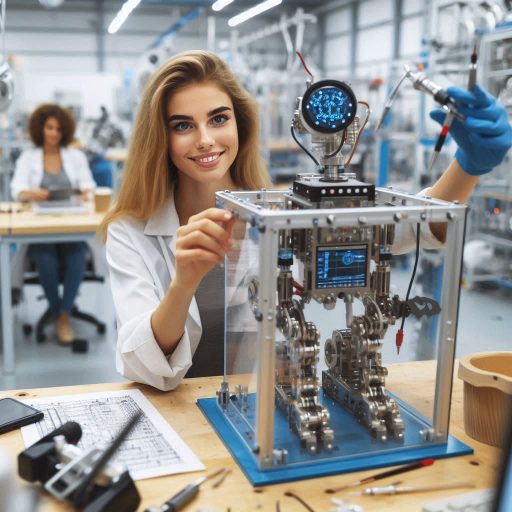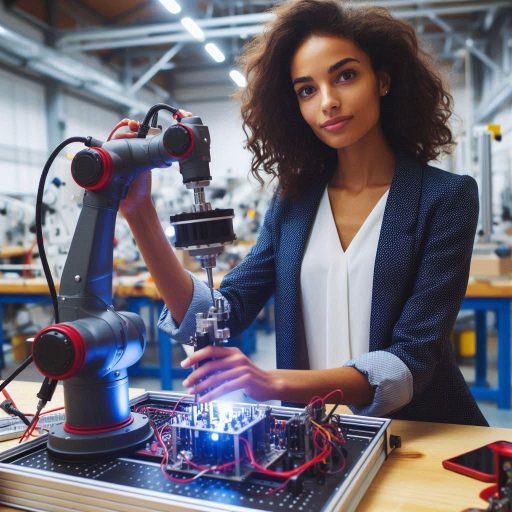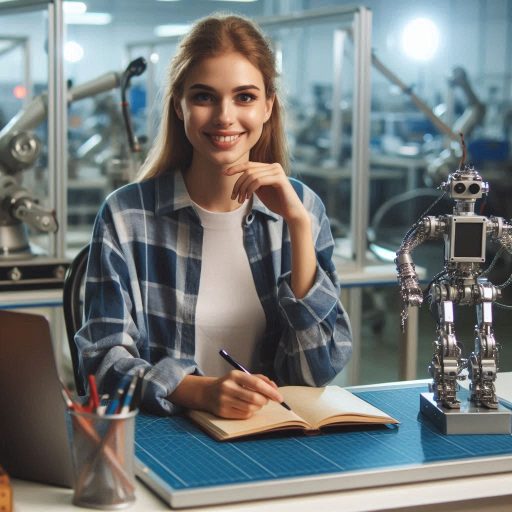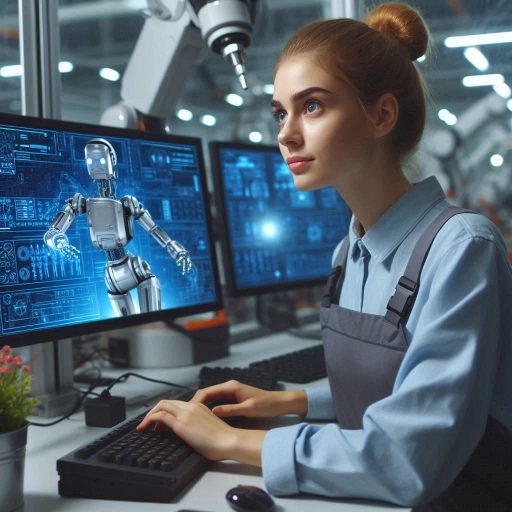Introduction
Overview of Robotics Engineering in Manufacturing
Robotics engineering has brought transformative changes to the manufacturing industry.
This field focuses on designing and deploying robots to automate various tasks within production lines.
The integration of robotics enhances both efficiency and precision in manufacturing processes, leading to substantial improvements across the sector.
Importance of Robotics in Manufacturing
Robots play a pivotal role in modern manufacturing environments.
They operate continuously, which significantly increases production speeds and reduces downtime.
The precision of robots ensures high-quality outputs with minimal errors.
Additionally, robots take on dangerous or monotonous tasks, thereby improving workplace safety for human workers and reducing the risk of injuries.
Their ability to perform repetitive tasks efficiently makes them invaluable in maintaining consistent product quality and meeting high production demands.
Thesis Statement
This blog will delve into the ways robotics engineering is reshaping manufacturing.
It will examine how robots enhance efficiency, precision, and safety in production processes.
The text will explore how robotics impact various manufacturing sectors, including automotive and electronics.
It will highlight robotics’ role in setting new industry standards and driving technological advancements.
History of Robotics Engineering in Manufacturing
Evolution of Robotics in Manufacturing
The evolution of robotics in manufacturing has transformed the industry over decades.
The journey began in the early 20th century with basic mechanized systems.
These machines performed repetitive tasks, paving the way for more sophisticated automation.
By the 1950s, the concept of programmable robots emerged, revolutionizing manufacturing processes.
Key Early Developments
- 1920s: Introduction of basic mechanized assembly lines.
- 1940s: Use of transfer machines in production, laying the foundation for automation.
- 1954: George Devol invented the first programmable robot, Unimate, marking the birth of industrial robotics.
Unimate, the first industrial robot, was installed at General Motors in 1961.
This event marked a significant turning point in manufacturing.
Robots began to handle dangerous and repetitive tasks, enhancing worker safety and productivity.
Key Milestones in the Development of Robotics Technology for Manufacturing
Robotics technology in manufacturing has seen remarkable advancements.
These milestones highlight the journey:
- 1960s: Unimate’s success led to widespread adoption of robotics in automotive manufacturing.
Robots began performing tasks such as welding and material handling. - 1970s: The introduction of microprocessors enabled the development of more sophisticated and precise robotic systems.
Robots became integral to automated production lines. - 1980s: The emergence of computer-aided design (CAD) and computer-aided manufacturing (CAM) systems revolutionized robot programming.
This advancement allowed for greater flexibility and precision in manufacturing. - 1990s: The integration of robotics with computer vision systems enabled robots to perform complex tasks with high accuracy.
This era also saw the rise of collaborative robots (cobots) designed to work alongside humans. - 2000s: Robotics technology advanced with the development of artificial intelligence (AI) and machine learning.
Robots became capable of adaptive learning and decision-making, leading to smarter manufacturing processes. - 2010s: The Internet of Things (IoT) and Industry 4.0 further enhanced robotics in manufacturing.
Robots now connect seamlessly with other systems, optimizing production and supply chains.
Impact of Robotics on the Manufacturing Industry Over the Years
The impact of robotics on manufacturing has been profound.
Robotics engineering has revolutionized the industry by increasing efficiency, reducing costs, and improving quality.
Major Impacts
- Increased Efficiency: Robots operate 24/7 without fatigue, significantly boosting production rates.
- Cost Reduction: Automation reduces labor costs and minimizes errors, leading to cost savings.
- Quality Improvement: Robots perform tasks with precision, ensuring consistent product quality.
Over the years, robotics has also enhanced workplace safety by taking over hazardous tasks.
This shift has led to fewer workplace injuries and a focus on more complex, value-added tasks by human workers.
The history of robotics in manufacturing showcases a continuous drive for innovation, leading to an industry transformed by automation and advanced technology.
As robotics technology continues to evolve, its impact on manufacturing will only grow, driving further advancements and efficiencies.
dle complex tasks with speed and accuracy, reducing human error.
With the rise of Industry 4.0, robotics has become a key component in smart factories, driving innovation and competitiveness.
Read: Best Online Courses for CAD Technician Training
Applications of Robotics in Manufacturing
Robotics engineering has revolutionized manufacturing, driving efficiency, precision, and safety.
Below are key applications of robotics in the industry.
Automation of Assembly Lines
Robots have transformed assembly lines by automating repetitive tasks.
They perform with unmatched precision, reducing human error.
Tasks like fastening, soldering, and component placement are now faster and more accurate.
This automation not only boosts production speed but also ensures consistent product quality.
Material Handling and Sorting
Material handling is another area where robotics excels. Robots transport, lift, and sort materials with ease.
They handle heavy loads and work in hazardous environments, minimizing workplace injuries.
Automated sorting systems use robotics to identify and categorize products, streamlining inventory management and reducing human labor.
Quality Control and Inspection
Robots play a crucial role in quality control.
Equipped with advanced sensors and cameras, they inspect products for defects, ensuring high standards.
These systems detect flaws invisible to the human eye, such as micro-cracks or surface irregularities.
Automated inspection enhances quality assurance while reducing waste.
Welding, Painting, and Other Specialized Tasks
Robots perform specialized tasks like welding, painting, and sealing with precision.
In welding, robots maintain consistent heat and pressure, producing strong and uniform welds.
In painting, they apply coatings evenly, reducing waste and ensuring a smooth finish.
Robots also handle tasks like gluing and sealing, improving product durability and appearance.
Case Studies of Successful Implementation
- Automotive Industry: A leading car manufacturer implemented robotic welding systems, improving production speed by 30% and reducing defects.
- Electronics Manufacturing: A global electronics company implemented robots for assembly and inspection.
This boosted production capacity by 25% and greatly reduced defects. - Food and Beverage Industry: A major food producer used robots for packaging and sorting, boosting efficiency by 40% and cutting down on packaging errors.
Basically, robotics in manufacturing offers numerous benefits, from increased efficiency to enhanced product quality.
Robotics engineering automates assembly lines, enhances material handling, ensures rigorous quality control, and performs specialized tasks.
It drives the future of manufacturing.
Real-world success stories demonstrate the transformative impact of robotics, proving that automation is key to staying competitive in today’s market.
Read: Top Companies Hiring CAD Technicians in the USA
Advantages of Robotics Engineering in Manufacturing
Robotics engineering has brought significant advancements to the manufacturing industry.
Below are the key advantages of integrating robotics into manufacturing processes.
Increased Production Efficiency and Speed
Robots operate at a consistent pace, allowing for faster production times.
They don’t need breaks, resulting in continuous operation.
This increased efficiency means manufacturers can produce more units in less time.
Automated systems streamline processes, reducing downtime and maximizing output.
The result is a substantial boost in production speed and overall efficiency.
Improved Product Quality and Consistency
Robots perform tasks with precision, ensuring consistent quality in every product.
They follow programmed instructions, minimizing variations and defects.
This accuracy leads to higher-quality products and fewer recalls.
Automated inspection systems detect imperfections that human inspectors might miss, further enhancing quality control.
Consistency in production ensures customer satisfaction and brand reliability.
Reduction in Labor Costs and Human Error
Automating repetitive tasks reduces the need for manual labor, leading to significant cost savings.
Robots handle mundane and physically demanding tasks, allowing workers to focus on more complex responsibilities.
This shift reduces the likelihood of human error, which can lead to costly mistakes.
Fewer errors mean less waste, further lowering production costs.
Transform Your Career Today
Unlock a personalized career strategy that drives real results. Get tailored advice and a roadmap designed just for you.
Start NowEnhanced Workplace Safety for Workers
Robots perform dangerous tasks, protecting workers from hazardous environments.
They handle heavy lifting, exposure to harmful substances, and operations in extreme temperatures.
By taking on these risky jobs, robots reduce workplace injuries and fatalities.
The improved safety record contributes to a better work environment and lowers insurance and compensation costs.
Environmental Benefits Through Optimized Resource Usage
Robotics engineering promotes sustainable manufacturing practices by optimizing resource usage.
Robots operate with high precision, reducing material waste and energy consumption.
Automated systems monitor and adjust processes in real time, ensuring efficient use of resources.
This optimization leads to lower environmental impact and supports green manufacturing initiatives.
Additionally, robots can help in recycling and repurposing materials, further contributing to sustainability.
In essence, the integration of robotics in manufacturing offers numerous advantages.
Increased production efficiency and speed, improved product quality, reduced labor costs, enhanced workplace safety, and environmental benefits make robotics a valuable asset in modern manufacturing.
As technology continues to advance, the role of robotics in manufacturing will only grow, driving the industry toward greater innovation and sustainability.
Read: Future of CAD Technician Jobs in Engineering
Challenges and Limitations of Robotics in Manufacturing
While robotics engineering offers numerous advantages in manufacturing, it also presents challenges and limitations that companies must navigate.
Below are key areas where these challenges arise.
Initial High Costs of Implementation and Maintenance
One of the most significant barriers to adopting robotics in manufacturing is the initial high cost.
Purchasing advanced robotic systems and integrating them into existing production lines require substantial investment.
Additionally, maintaining these systems can be expensive, especially when considering the need for regular updates, repairs, and parts replacement.
For small and medium-sized enterprises, these costs can be prohibitive, limiting access to advanced robotic technologies.
Need for Specialized Training and Technical Expertise
Robotic systems require operators with specialized training and technical expertise.
Workers must understand programming, maintenance, and troubleshooting to manage these systems effectively.
The need for such skills can lead to additional costs in training and hiring.
Companies need to invest in continuous education to keep their workforce current with advancements.
This can be challenging, especially for organizations with limited resources.
Potential Job Displacement for Workers
The automation of tasks traditionally performed by humans can lead to job displacement.
Robots take over repetitive and labor-intensive jobs, reducing the need for human workers in certain roles.
While this shift can lead to higher efficiency and productivity, it also raises concerns about unemployment and the social impact of reduced job opportunities.
Companies must balance the benefits of automation with the need to support their workforce, potentially through retraining programs and redeployment in new roles.
Vulnerability to Cyber Attacks and Security Risks
As manufacturing systems become increasingly interconnected, they also become more vulnerable to cyber attacks.
Robotic systems, particularly those integrated with IoT devices, are at risk of hacking, data breaches, and other security threats.
A successful cyber attack can disrupt production, cause significant financial losses, and damage a company’s reputation.
Ensuring robust cybersecurity measures is essential, but it also adds complexity and cost to the implementation of robotic systems.
Limitations in Flexibility and Adaptability for Changing Production Needs
Robotic systems excel at performing specific tasks with high precision and efficiency, but they often lack flexibility.
Adapting robots to new tasks or changing production requirements can be challenging and costly.
Unlike human workers who can easily switch between different tasks, robots require reprogramming and sometimes hardware adjustments to accommodate new processes.
This limitation can hinder a company’s ability to respond quickly to market changes or customize production to meet varying customer demands.
Therefore, robotics engineering in manufacturing brings both opportunities and challenges.
Companies must weigh the benefits of automation against the costs, training needs, potential job displacement, security risks, and flexibility limitations.
Addressing these challenges is crucial to fully leveraging the potential of robotics in manufacturing while minimizing the associated risks.
sponsiveness of the manufacturing operation.
Addressing these challenges and limitations is essential for companies looking to leverage robotics in manufacturing effectively.
By developing strategies to mitigate risks and optimize robotics systems, manufacturers can unlock the full potential of automation in their operations.
Read: How to Build a Strong CAD Technician Portfolio
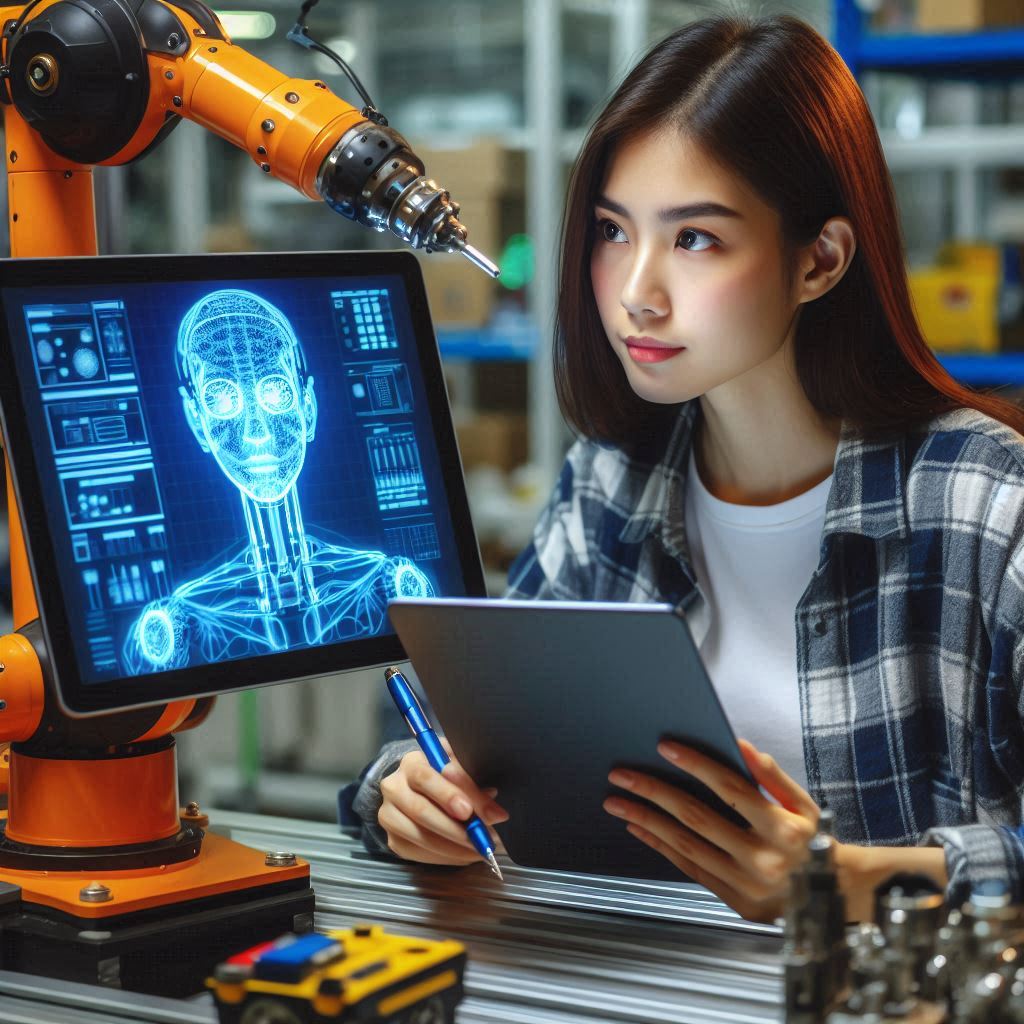
Current Trends and Innovations in Robotics Engineering for Manufacturing
Robotics engineering in manufacturing is rapidly evolving, driven by technological advancements and the demand for greater efficiency.
Below are the key trends and innovations shaping the future of robotics in manufacturing.
Integration of Artificial Intelligence and Machine Learning
Artificial intelligence (AI) and machine learning (ML) are revolutionizing robotics in manufacturing.
Robots equipped with AI and ML can analyze data, learn from experiences, and improve performance over time.
This capability allows robots to optimize production processes, predict maintenance needs, and adapt to changing conditions.
AI-driven robots also enhance decision-making, enabling more efficient and flexible manufacturing operations.
Collaborative Robots (Cobots) Working Alongside Humans
Collaborative robots, or cobots, are designed to work safely alongside humans.
Unlike traditional industrial robots, cobots are equipped with advanced sensors and safety features to prevent accidents.
They assist human workers in tasks that require precision, strength, or repetitive motion.
Cobots improve productivity by taking over monotonous tasks, allowing human workers to focus on more complex and creative aspects of manufacturing.
Adoption of Industry 4.0 Technologies for Smart Manufacturing
Industry 4.0, characterized by the integration of digital technologies into manufacturing, is transforming the industry.
Smart factories leverage robotics, the Internet of Things (IoT), and data analytics to create highly connected and automated production environments.
Robots in smart manufacturing systems communicate with each other and other machines, optimizing workflows and reducing downtime.
This level of automation enhances efficiency, reduces costs, and improves product quality.
Development of Advanced Sensors and Vision Systems for Automation
Advanced sensors and vision systems are critical to the success of automation in manufacturing.
These technologies enable robots to perceive their environment, detect objects, and make real-time decisions.
For example, robots equipped with 3D vision systems can identify and manipulate parts with high precision.
Advanced sensors allow robots to perform complex tasks like welding, painting, and assembly with greater accuracy and consistency, ensuring high-quality output.
Exploration of New Materials and Designs for Robots in Manufacturing
The development of new materials and innovative designs is pushing the boundaries of what robots can achieve in manufacturing.
Lightweight materials like carbon fiber and advanced polymers are being used to create more agile and durable robots.
These materials reduce energy consumption and enhance the robots’ ability to perform complex tasks.
Additionally, new designs, such as modular and flexible robots, allow for easier customization and adaptation to various manufacturing processes.
Showcase Your Business Today
Reach thousands of readers actively exploring professional services. Publish your business profile and grow your audience now.
Publish NowIn review, the current trends and innovations in robotics engineering are redefining manufacturing.
AI and ML integration, cobots, Industry 4.
0 technologies, advanced sensors, and new materials are driving the industry forward.
These advancements are not only improving efficiency and productivity but also enabling more intelligent and flexible manufacturing processes.
As these technologies evolve, robotics will make manufacturing smarter, more efficient, and more innovative.
The future of production environments looks increasingly promising.
orking alongside humans to create more efficient, flexible, and intelligent manufacturing systems.
Future Prospects for Robotics Engineering in Manufacturing
Robotics engineering is poised to play a central role in the future of manufacturing.
As technology advances, we can expect significant growth, innovation, and challenges in this field.
Predictions for Growth and Expansion
The demand for robotics in manufacturing is expected to surge in the coming years.
Companies will increasingly adopt robotics to enhance efficiency, reduce costs, and maintain a competitive edge.
A growing trend towards smart factories will drive the integration of robotics with AI, IoT, and machine learning.
This convergence will enable more autonomous and adaptable manufacturing processes, pushing the boundaries of what robots can achieve.
- Increased Adoption: More industries will implement robotics to streamline operations and boost productivity.
- Smart Factories: Robotics will integrate with advanced technologies like AI and IoT for enhanced automation.
- Global Expansion: The robotics market will expand globally, particularly in emerging economies.
Opportunities for Innovation and Advancements
Robotics engineering will continue to evolve, presenting numerous opportunities for innovation.
New materials, sensors, and AI capabilities will enhance robot performance and versatility.
Robotics engineers will develop machines that are more adaptive, collaborative, and capable of handling complex tasks.
- Adaptive Robotics: Future robots will adjust to varying tasks and environments more efficiently.
- Collaborative Robots (Cobots): Cobots will work alongside humans, improving safety and productivity in the workplace.
- AI Integration: Enhanced AI will enable robots to learn and improve from their experiences, leading to smarter systems.
Potential Challenges and Obstacles
While the future of robotics in manufacturing is promising, several challenges must be addressed.
High initial costs and the need for skilled labor to operate and maintain advanced robotics may hinder adoption in some sectors.
Additionally, the rapid pace of technological advancement could lead to issues with integration and compatibility.
- High Costs: The expense of implementing advanced robotics may be prohibitive for smaller companies.
- Skills Gap: A shortage of skilled workers to manage and maintain robotics systems could slow growth.
- Integration Issues: As new technologies emerge, ensuring compatibility with existing systems will be crucial.
Role of Robotics in Shaping the Future of Manufacturing
Robotics will fundamentally reshape the manufacturing industry, driving efficiency, customization, and sustainability.
The shift towards automated and smart manufacturing will allow companies to produce goods faster, with greater precision and lower costs.
Robotics will also enable more sustainable manufacturing practices, reducing waste and energy consumption.
- Efficiency: Robotics will streamline production processes, reducing time and labor costs.
- Customization: Advanced robotics will allow for more flexible and customizable manufacturing.
- Sustainability: Robotics will support greener manufacturing practices by minimizing waste and resource use.
Lastly, the future of robotics engineering in manufacturing is bright, with significant opportunities for growth, innovation, and industry transformation.
However, to fully realize this potential, companies must overcome challenges related to cost, skills, and integration.
As robotics continues to evolve, it will play a crucial role in shaping the future of manufacturing, driving efficiency, customization, and sustainability.
Conclusion
This blog post explored the pivotal role of robotics in transforming manufacturing processes.
Covering key areas such as automation, material handling, and quality control.
Robotics engineering has revolutionized these aspects, significantly enhancing efficiency, precision, and safety in manufacturing.
As we look to the future, the integration of robotics is set to play an even greater role, promising advancements that will further redefine the industry.
The significance of robotics engineering cannot be overstated; it is the driving force behind modern manufacturing’s evolution.
For those interested in the field, now is the time to explore opportunities in robotics engineering and the manufacturing industries.
As the industry continues to grow and innovate, engaging with robotics offers a path to staying competitive and leading in an increasingly automated world.
Embrace the potential of robotics and be part of the transformation shaping the future of manufacturing.ation and robotics to stay relevant in the ever-changing landscape of manufacturing.
[E-Books for Sale]
The Big Book of 500 High-Paying Jobs in America: Unlock Your Earning Potential
$19.99 • 500 High-Paying Jobs • 330 pages
Explore 500 high-paying jobs in America and learn how to boost your career, earn more, and achieve success!
See All 500 High-Paying Jobs of this E-Book
1001 Professions Without a Degree: High-Paying American Jobs You Can Start Now
$19.99 • 1001 Professions Without a Degree • 174 pages
Discover 1001 high-paying jobs without a degree! Unlock career tips, skills, and success strategies for just $19.99!

